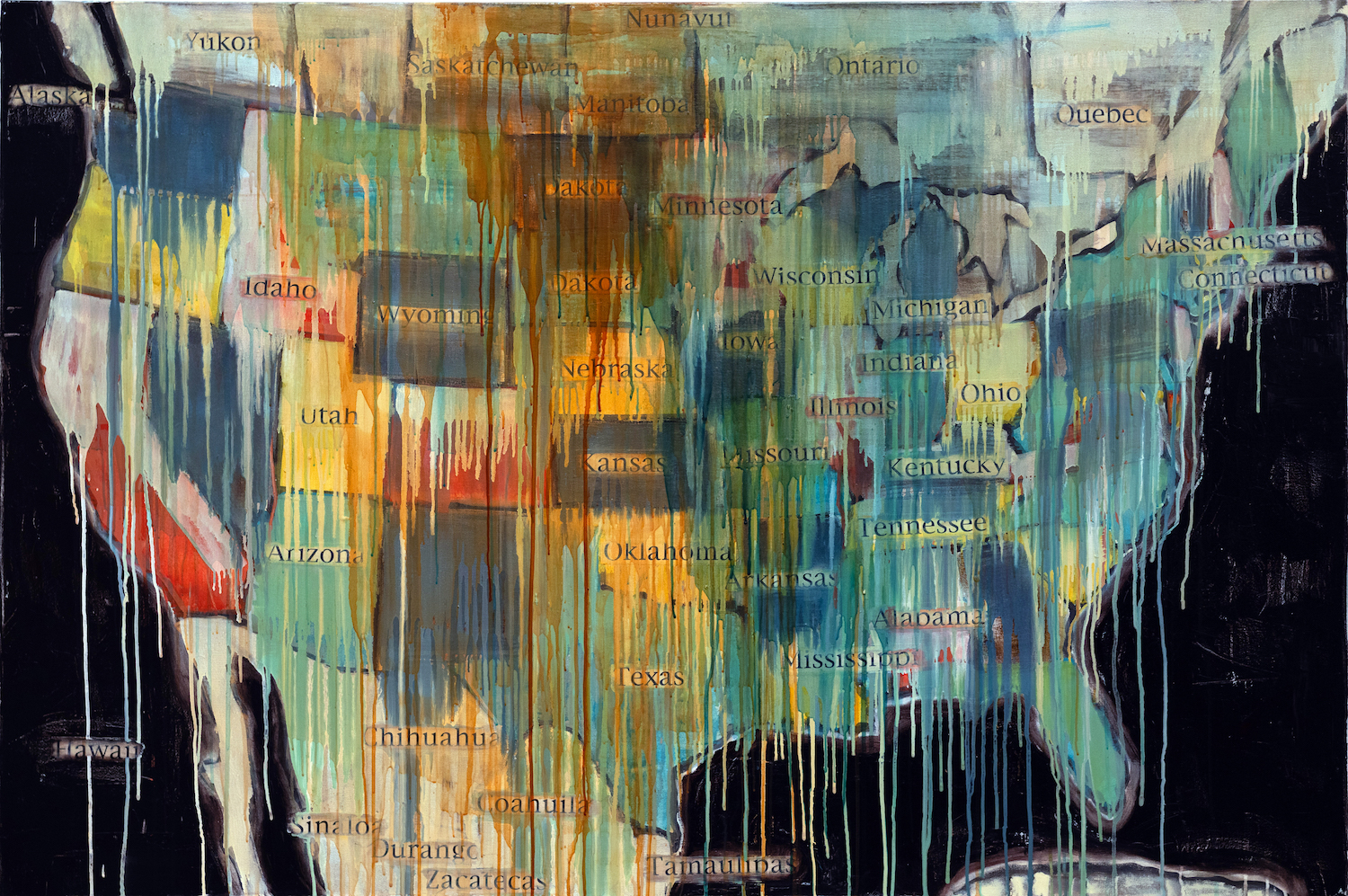Jaune Quick-To-See Smith’s State Names (2000) will be useful in the study of:
- The history of activism in the United States
- Race and national identity
- American and national identity and the American landscape
- The Indian Removal Act
- The Trail of Tears
By the end of this lesson, students should be able to:
- Discuss State Names as a primary document that links to its specific historical context during the twentieth century
- Identify the artist’s motivation for the artistic decisions made in making the work
- Discuss the interaction between the past and the present for Native Americans in the United States

Jaune Quick-To-See Smith, State Names, 2000 (Smithsonian American Art Museum, image: Dr. Steven Zucker (CC BY-NC-SA 2.0)
1. Look closely at the painting
Look closely at State Names by Jaune Quick-To-See Smith (zoomable images, available for download for teaching)
Questions to ask:
- Describe the painting. What parts of it stand out to you?
- What art materials can you identify? How has the artist manipulated them?
2. Watch the video
The video “What’s in a map? Reading the United “States” in Jaune Quick-To-See Smith’s State Names” is only five minutes long. Ideally, the video should provide an active rather than a passive classroom experience. Please feel free to stop the video to respond to student questions, to underscore or develop issues, to define vocabulary, or to look closely at parts of the painting that are being discussed. Key points, a self-diagnostic quiz, and high resolution photographs with details of State Names are provided to support the video.
3. read about the painting and its historical context
Familiar/unfamiliar
Jaune Quick-To-See Smith has said that she likes to use maps because maps tell stories. In the case of State Names, we can see her characteristic use of an instantly recognizable icon (the map) that has been altered so that when we get close, what we expect is not what we see. Drips of paint obscure state boundaries, and some of the state names are missing.
Identity and history
Jaune Quick-To-See Smith has said that her maps are points of departure for the political treatment of Native people, and that she cannot say strongly enough that her maps are about stolen lands. She began using maps in her artistic practice when she was making works that were responding to the Columbus quincentennial in 1992, directly relating to the beginnings of European colonization of North America. She has removed the names of states that have European origins, leaving only states (and areas of Canada and Mexico) with names derived from indigenous sources. Quick-To-See Smith is an enrolled member of the Confederated Salish and Kootenai Tribes of the Flathead Nation, and her art is meant to say something about her own identity and the identity of her people.
Art and history
Quick-To-See Smith was trained as an Abstract Expressionist, and her work exists in dialogue with techniques associated with iconic artists such as Robert Rauschenberg, Jasper Johns, and Jackson Pollock, but her use of these techniques are grounded in challenging the viewer to think about identity, heritage, and history in different ways, something that these other artists were not interested in.
4. Discussion questions
- What do you think Quick-To-See Smith hopes to accomplish by making works like State Names? How much power does art have to change minds and shape the future?
- How often do you use maps in your daily life? What do you think maps are for? Can maps be for other things than the ones you use them for? What makes a map a map?
5. Research questions
- Maps have a long history, with many different reasons for creating them. Find two maps from two different cultures and compare them. What are the maps meant to represent? What ideas do they incorporate? How are they a part of the culture that produced them?
- Using resources like this timeline, choose an example of a time when Native Americans were pushed off of their lands by non-Native forces. Find maps that illlustrate this displacement. Where do those Native groups live now? How is the land they were forced to move to the same or different from the one they were driven from? Does it have the same climate, geography, and resources? What reasons were given for their land being taken?
6. Bibliography
See State Names at the Smithsonian American Art Museum
Jaune Quick-To-See Smith’s artist website
View a timeline that details Native Americans’ fight to keep their rights from the National Archives
Read about the ideological and political implications of cartography (map-making)
View this online exhibition on maps in American culture
Learn more about the history and cultural impact of Indian removal from their native land
Learn about Manifest Destiny and westward expansion in the United States
Learn more about Abstract Expressionism
Artist interview with Jaune Quick-To-See Smith (The Smithsonian American Art Museum)





